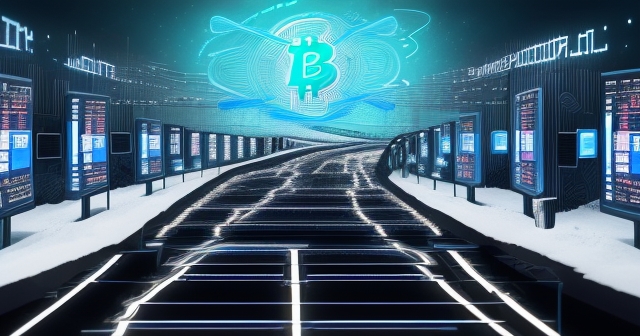“`html
Understanding Blockchain Forks: Navigating Network Evolution and Crypto Asset Creation
Welcome to our exploration of blockchain forks, a fundamental concept for anyone seeking to truly grasp the dynamics of decentralized networks and the often-volatile world of cryptocurrencies. As participants in this revolutionary technological shift, it’s essential to understand how these digital ledgers evolve, adapt, and sometimes, diverge. Forks aren’t merely technical jargon; they are pivotal events that can redefine network functionality, introduce new digital assets, and significantly impact the market landscape you navigate.
- Blockchain forks can result in the creation of new cryptocurrencies and impact existing markets.
- Understanding fork types—hard and soft—helps predict network behavior and asset dynamics.
- Participants in the blockchain community play essential roles in the decision-making process surrounding forks.

Perhaps you’ve heard terms like “Hard Fork” or “Soft Fork” mentioned in relation to network upgrades or controversial community decisions. Maybe you’ve wondered how a new cryptocurrency seemingly appears out of thin air, sharing a history with a well-established coin. These phenomena are intrinsically linked to the concept of a blockchain fork. Think of a blockchain not just as a single, immutable chain of blocks, but as a codebase, a set of rules, and a community, all interacting. When fundamental changes are proposed or necessary, this interaction can lead to a fork.
Our goal today is to demystify blockchain forks for you, guiding you through the technical underpinnings, the economic implications, and the real-world examples that have shaped the crypto ecosystem. We will approach this topic like a complex puzzle, breaking down each piece to reveal the complete picture. By the end of our discussion, you should feel more confident in understanding why forks happen, how they affect network participants (including you as a potential investor or trader), and what risks and opportunities they might present.
So, let’s begin our journey into the fascinating world of blockchain forks. What exactly are they, and why are they such a crucial part of the decentralized technology narrative?
Defining the “Fork”: A Divergence in the Digital Ledger
At its core, a blockchain is a distributed ledger, a continuously growing list of records, called blocks, which are linked together using cryptography. Each block contains a cryptographic hash of the previous block, a timestamp, and transaction data. This structure inherently creates a chronological chain. However, the operation of this chain is governed by a set of rules – the blockchain protocol. This protocol dictates everything from how transactions are validated and blocks are mined (or validated) to the block size, the consensus mechanism (like Proof-of-Work or Proof-of-Stake), and the reward structure.
A blockchain fork occurs when there is a change or divergence in this underlying protocol or in the chain’s history accepted by different parts of the network. Imagine the blockchain as a river flowing consistently. A fork is like the river splitting into two or more paths. This split happens because different participants on the network – be it miners, nodes, or developers – might come to a different agreement about the next legitimate block or a new set of rules for validating blocks and transactions.
Why would such a divergence happen? Blockchains, like any software system, need updates, improvements, and sometimes, critical fixes. As decentralized systems, reaching agreement on these changes is more complex than updating a centralized database. Changes to the protocol require consensus among network participants. When there isn’t complete consensus, or when proposed changes break compatibility with older versions of the software, a fork can emerge.
Forks can be intentional, planned events designed to upgrade the network, or unintentional, temporary occurrences caused by network latency or near-simultaneous block creation. Regardless of the cause, a fork represents a moment of decision for the network, a point where the chain’s future path is determined based on which rules are followed or which history is recognized by the majority of participants.
The Fundamental Split: Understanding Hard Forks
Let’s first delve into what is often considered the more impactful type of fork: the Hard Fork. A hard fork is a radical change to the blockchain protocol that is not backward-compatible. What does “not backward-compatible” mean in this context? It means that nodes or clients running the old version of the software will no longer be able to recognize or validate blocks created by nodes running the new version, and vice versa. The new rules are so fundamentally different that the old rules are simply incompatible.

Because the new rules are incompatible with the old, a hard fork essentially forces all network participants (especially miners and full node operators) to upgrade their software to the new version if they wish to continue participating in validating the chain that follows the new rules. If a significant portion of the network participants decides *not* to upgrade, they will continue to follow the old rules, processing transactions and mining blocks according to the original protocol. This simultaneous existence of two incompatible rule sets leads to a permanent chain split.
At the block height where the hard fork occurs, the blockchain effectively branches. One chain continues under the old rules (the ‘old chain’), and another chain continues under the new rules (the ‘new chain’). Both chains share the same history up to the point of the fork. Consequently, anyone who held cryptocurrency on the original chain at the time of the fork will now hold the same amount of cryptocurrency on *both* the old chain and the new chain.
Hard forks are frequently used to implement significant protocol upgrades, add major new features, or sometimes, to reverse controversial transactions. A famous example is the Ethereum hard fork that occurred after the DAO hack in 2016. A majority of the community agreed to fork the chain to reverse the malicious transaction and restore the stolen funds. The chain that followed the new rules became the current Ethereum (ETH), while the chain that continued following the old rules became Ethereum Classic (ETC). Another prominent example is the Bitcoin Cash (BCH) hard fork from Bitcoin (BTC) in 2017, driven by a disagreement over increasing the block size limit to improve scalability.
Hard forks can be contentious if there is significant disagreement within the community regarding the proposed changes, or they can be non-contentious if there is overwhelming consensus for the upgrade, and the old chain is effectively abandoned. Contentious hard forks can lead to community fragmentation and the creation of competing cryptocurrencies, each with its own network, development team, and market value.
The Backward-Compatible Path: Exploring Soft Forks
In contrast to the disruptive nature of hard forks, a Soft Fork represents a change to the blockchain protocol that is backward-compatible. This means that nodes or clients running the new, upgraded software will still accept blocks created by nodes running the old version, even though the old nodes don’t fully understand or enforce the *new* rules. However, nodes running the *old* software will *not* accept blocks created by upgraded nodes if those blocks violate the new rules.

Let’s use our river analogy again. If a hard fork is the river splitting into two distinct paths, a soft fork is like narrowing the river’s channel or adding a new rule about what kind of boats are allowed. Boats (blocks) that follow the new, stricter rules are still perfectly valid in the wider, older channel. But boats that *only* fit the wider channel (violating the new rules) won’t be accepted downstream by those who have adapted to the narrower channel.
Because upgraded nodes enforce the new, stricter rules, and blocks following these stricter rules are still valid under the old rules, the network doesn’t necessarily split into two distinct chains. As more miners and nodes upgrade to the new software, the new rules become the dominant set of rules on the single chain. Non-upgraded nodes will continue to operate but might experience issues if they try to validate blocks that are only valid under the new rules or if they propose blocks that violate the new rules.
Soft forks are often used for implementing minor protocol enhancements, efficiency improvements, or security patches that restrict the types of transactions or blocks that are considered valid. Examples of soft forks on the Bitcoin network include Segregated Witness (SegWit), which changed the way transaction data was stored to improve scalability and fix transaction malleability, and Taproot, which brought about greater privacy and flexibility for smart contracts.
Soft forks are generally less disruptive than hard forks because they do not necessarily require everyone to upgrade simultaneously to avoid a chain split. However, for the new rules to be truly effective and enforced across the network, a significant majority (often requiring a certain percentage of mining power or signaling from nodes) must adopt the new software. If this doesn’t happen, the soft fork might not achieve its intended outcome or could still lead to temporary network instability if non-upgraded nodes create invalid blocks according to the new rules.
Why Networks Diverge: Core Reasons for Instigated Forks
Understanding the technical distinctions between hard and soft forks leads us to a crucial question: why do blockchains need to fork in the first place? What motivates developers, miners, and the community to propose and implement such significant changes? The reasons for initiating a fork are diverse, reflecting the dynamic and evolving nature of decentralized technologies and the communities that support them.
| Reason for Fork | Description |
|---|---|
| Protocol Upgrades | Improvements and bug fixes are added to enhance functionality. |
| Security Vulnerabilities | Critical issues must be resolved to protect the network from attacks. |
| Community Disagreements | Diverging visions among community members prompt forks. |
One primary driver is the need for protocol upgrades and feature additions. Like any software, blockchain protocols aren’t perfect from day one. As technology advances and user needs change, new features might be desired – perhaps improved scalability to handle more transactions (like SegWit or proposals to increase block size), enhanced privacy features (like Taproot), or the introduction of new functionalities like smart contract capabilities on chains that didn’t originally support them. Implementing these substantial changes often requires altering the core rules of the protocol, which necessitates a fork.
Bug fixes and security vulnerabilities are another critical reason. Discovering a vulnerability in the existing protocol can put the entire network and its assets at risk. To patch these security holes swiftly and effectively, a forced upgrade via a fork might be necessary. While minor bugs can sometimes be fixed with simple software updates, fundamental flaws affecting consensus or transaction validity often require a protocol-level change implemented through a soft or hard fork.
Sometimes, forks are initiated to reverse malicious transactions or address the fallout from significant security incidents. The most famous instance is the Ethereum hard fork following the 2016 DAO hack, where a large amount of Ether was siphoned off due to a smart contract vulnerability. The community and core developers made the difficult decision to fork the chain and return the funds to their original owners, effectively erasing the hack from the ‘official’ history. This was a highly controversial move, demonstrating that forks can be tools for governance and intervention, not just technical upgrades.
Finally, and perhaps most contentiously, forks can arise from community disagreements and differing visions for the network’s future direction. In decentralized ecosystems, there’s no single authority dictating the path forward. Discussions about core philosophies – such as the balance between decentralization and scalability, or the role of miners vs. other participants – can lead to irreconcilable differences. When consensus on a critical issue cannot be reached, a hard fork allows the dissenting faction to create their own version of the blockchain, implementing their preferred rules. The Bitcoin Cash fork is a prime example of such an ideological split over scalability solutions (larger blocks vs. SegWit and layer-2 solutions).
These instigating factors highlight that forks are not merely technical events; they are often the culmination of social, economic, and political processes within a decentralized community, reflecting the ongoing challenge of collective governance in the absence of central control.
Accidental Forks: The Unintended Splits and Their Resolution
While intentional forks are planned events resulting from deliberate protocol changes or community decisions, blockchains can also experience unintentional forks. These occur naturally as a consequence of the decentralized and asynchronous nature of distributed networks, particularly in Proof-of-Work systems, and are typically temporary.
How do these accidental splits happen? The most common cause is related to the block discovery process in Proof-of-Work. When two different miners solve the cryptographic puzzle and find a valid block almost simultaneously, their blocks might be propagated through the network at roughly the same time to different sets of nodes. Some nodes might receive Block A first and start building on it, while others receive Block B first and start building on that. For a short period, the network is split into two branches, each believing a different block is the latest valid one.

These simultaneously mined blocks are often referred to as “orphan blocks” (in Bitcoin terminology, though they are not truly orphans as they have a parent) or “uncle blocks” (in Ethereum terminology). This situation creates a temporary fork where the chain has two competing tips.
The resolution of unintentional forks is built into the consensus mechanism itself. In Proof-of-Work blockchains, the longest chain (the one with the most cumulative computational work) is considered the valid chain. As miners continue to build on either branch of the fork, eventually, one branch will find the next block first. This block extends that branch, making it longer than the other. When this happens, the nodes that were building on the shorter branch recognize the longer chain as the canonical one and abandon their shorter branch, switching their mining efforts to extend the longer chain. The transactions in the abandoned blocks are returned to the memory pool to be included in a future block on the winning chain.
This process of resolving temporary forks is a normal part of blockchain operation and is typically resolved within minutes, or at most, hours, depending on the network’s block time and propagation speed. It underscores the probabilistic finality of transactions on Proof-of-Work chains – a transaction is considered more final the deeper the block containing it is buried under subsequent blocks, as the risk of that block being on an abandoned branch of a temporary fork diminishes significantly with each new block added.
While usually harmless and self-correcting, frequent accidental forks could indicate underlying network or software issues. Understanding them helps illustrate the robustness and self-healing properties designed into these decentralized systems, ensuring that despite temporary disagreements on the chain’s state, consensus on the single, true history is eventually reached.
Community, Consensus, and Governance: The Human Element in Forging
Beyond the technical mechanics, blockchain forks are deeply intertwined with the concepts of community, consensus, and governance. In a decentralized system, there’s no central authority that can simply mandate a software update or protocol change. Decisions about the network’s future, including whether and how to fork, rest with the diverse group of participants who operate and use the network.
| Role | Description |
|---|---|
| Core Developers | Individuals who write and maintain the blockchain software code. |
| Miners/Validators | Those who use computational power or stake to validate transactions and create new blocks. |
| Full Node Operators | Individuals or entities who run software validating every transaction and block. |
| Users and Investors | People who use or hold cryptocurrency, influencing market dynamics. |
Implementing a major change via a fork requires navigating the complexities of decentralized governance. This often involves public discussion, proposal systems (like Bitcoin Improvement Proposals (BIPs) or Ethereum Improvement Proposals (EIPs)), social media debates, and sometimes, informal signaling mechanisms (like miners signaling support for a soft fork within blocks they mine). Reaching consensus – a state where a sufficient majority agrees on a path forward – is paramount, particularly for soft forks which rely on broad adoption to enforce new rules without splitting the chain.
Contentious hard forks highlight the challenges when consensus breaks down. The Bitcoin block size debate, leading to the Bitcoin Cash fork, wasn’t just a technical argument; it was a philosophical divide about Bitcoin’s intended purpose and how to scale it. Similarly, the Ethereum DAO fork involved a moral and governance crisis – should the chain’s immutability be broken to correct a perceived injustice?
These events demonstrate that while the technology is decentralized, the decisions are made by humans with varying incentives, beliefs, and power dynamics. The success or failure of a fork, and which chain ultimately thrives, is not purely a technical outcome but also a social one, depending on which chain garners the most support from users, developers, miners, exchanges, and businesses. Understanding the human element – the community dynamics and governance processes – is just as important as understanding the code when analyzing why forks occur and their potential impact.
Navigating the Risks: Security Vulnerabilities Post-Fork
While forks serve as essential mechanisms for network evolution, they can also introduce significant security risks, particularly for users and for any new chain created by a hard fork. Awareness of these vulnerabilities is crucial for anyone holding or trading cryptocurrencies around the time of a fork event.
One of the most serious risks, especially for a newly created chain after a hard fork, is vulnerability to 51% attacks. In a Proof-of-Work system, a 51% attack occurs when a single entity or group controls more than 50% of the network’s total mining hash rate. With this much control, they could potentially disrupt the network by preventing new transactions from getting confirmations, or worse, by reversing completed transactions, enabling double spending. When a blockchain hard forks, the total hash rate that was securing the original chain is often split between the two resulting chains. The minority chain, attracting significantly less hash rate, becomes much easier and cheaper to attack with a 51% attack than the original, dominant chain. This was a major concern and a real problem for several Bitcoin forks, including Bitcoin Gold, which experienced multiple 51% attacks shortly after its launch.
Related to 51% attacks is the risk of double-spending attacks. This is where a malicious actor spends the same cryptocurrency coins multiple times. While blockchain consensus mechanisms are designed to prevent this, a 51% attack can allow an attacker to confirm their own malicious transactions while preventing legitimate ones from being confirmed, thereby facilitating double spending on the compromised chain.

Another critical security risk after a hard fork that creates a new chain with the same transaction format is a replay attack. Since both the original chain and the new chain share the same transaction history up to the fork block, a transaction valid on one chain might also be valid on the other. If you make a transaction on the original chain after the fork (e.g., sending coins to someone), an attacker might ‘replay’ that same transaction on the new chain, potentially causing you to lose the same amount of coins on the new chain without intending to spend them there. Robust forks implement replay protection mechanisms (like changing the transaction format or including a unique identifier) to prevent this, but not all forks do.
Beyond these on-chain attack vectors, forks can also pose risks related to wallet and exchange support. After a hard fork, not all wallets or exchanges may immediately support the new chain or the new asset. Users might need to export their private keys to access their coins on the new chain, a process that can be technically challenging and increases the risk of human error or falling victim to phishing scams. Lack of clear communication from platforms can lead to users losing access to their forked coins.
Mitigating these risks requires careful planning from developers (implementing replay protection), vigilance from miners (supporting the intended chain with hash rate), and education for users (understanding how to safely access and manage assets on newly created chains).
Economic Landscape Alterations: Asset Creation and Market Impact
Blockchain forks are not just technical events; they have profound economic consequences, most notably through the creation of new digital assets and their impact on market dynamics. For participants in the crypto market, understanding these economic shifts is as important as understanding the technology.
| Effect of Fork | Impact |
|---|---|
| Creation of New Cryptocurrency | Holders of the original coin receive equal amounts on the new chain. |
| Market Volatility | Speculation can lead to significant price fluctuations for both coins. |
| Community Fragmentation | Differing support can lead to decreased market strength for one or both assets. |
The most direct economic impact of a hard fork that results in a permanent chain split is the creation of a new cryptocurrency. As we discussed, anyone holding the original cryptocurrency at the block height of the fork now effectively holds an equal amount of the new cryptocurrency on the new chain. For example, if you held 10 BTC before the Bitcoin Cash fork, you would have held 10 BTC on the original chain and received 10 BCH on the new chain. This distribution of new tokens to existing holders is often referred to as an ‘airdrop’ or ‘claim’.
This sudden appearance of a new tradable asset immediately changes the market landscape. The total market capitalization of the crypto ecosystem increases (at least initially), and traders and investors gain a new instrument to speculate on. The value of the new asset is determined by market forces – supply, demand, community support, development activity, and perception of its future viability compared to the original chain.
Forks, particularly contentious ones, can also introduce significant market volatility. Before a contentious fork, speculation around the potential value of the new asset can drive trading activity in the original coin. Immediately after the fork, the market needs to price both the original coin and the new forked coin. Price discovery for the new asset can be highly volatile, influenced by exchange listing decisions, mining support shifts, and investor sentiment. The value of the original coin might also fluctuate as the market assesses the impact of the split and the loss of community/hash rate support to the new chain.
Forks can also lead to community fragmentation, which has economic consequences. Developers, users, and businesses may align with one chain over the other, leading to a division of resources, talent, and adoption. This fragmentation can affect the long-term viability and network effect of both chains. A chain that fails to attract sufficient development, mining power, or user adoption may see its value dwindle over time.
For investors, a hard fork presents both potential opportunities and risks. The opportunity lies in receiving a new asset for free, which could appreciate in value. The risk involves market volatility, the potential for one or both assets to depreciate, challenges in accessing the new asset, and the security risks discussed previously. Understanding the underlying reasons for the fork, the level of community support for each chain, and the technical implementation (like replay protection) is crucial for navigating these economic implications.
Historical Perspectives: Famous Forks and Their Legacy
Examining historical blockchain forks provides invaluable context for understanding their impact and consequences. Several key forks have profoundly shaped the cryptocurrency landscape, illustrating the technical, social, and economic dynamics at play.
The Bitcoin Cash (BCH) Fork (2017): Perhaps one of the most well-known examples of a contentious hard fork. The Bitcoin community had a long-standing debate about how to scale the network to handle more transactions. One faction favored increasing the block size limit (from 1MB to 8MB, and later larger) to process more transactions per block. Another faction supported SegWit (a soft fork) and the development of layer-2 solutions like the Lightning Network. Unable to reach consensus, proponents of larger blocks initiated a hard fork in August 2017, creating Bitcoin Cash (BCH). This split resulted in two competing chains and two cryptocurrencies, each with its own community, development teams, and market trajectories. BCH has itself forked further (e.g., Bitcoin SV – BSV), demonstrating how ideological splits can continue to propagate.

The Ethereum Hard Fork (DAO Hack Resolution, 2016): This fork is a classic example of a hard fork initiated to reverse a specific event – the theft of funds from a decentralized autonomous organization (DAO) built on Ethereum via a smart contract vulnerability. The community was divided: one side argued for immutability of the blockchain, even in the face of theft, while the other advocated for reversing the hack to recover funds and uphold justice. A majority voted to fork the chain. The new chain, where the hack was undone, continued as Ethereum (ETH). The minority chain, upholding immutability, became Ethereum Classic (ETC). This fork remains a significant case study in blockchain governance and the philosophical tension between immutability and intervention.
Bitcoin’s Segregated Witness (SegWit) Soft Fork (2017): A prime example of a complex soft fork. SegWit restructured the transaction format by ‘segregating’ the witness (signature) data from the transaction data, improving scalability and fixing transaction malleability without requiring a hard fork. As a soft fork, nodes and miners who didn’t upgrade could still process blocks from upgraded participants. However, for the new rules to be enforced and the benefits fully realized, a majority of mining power needed to signal support and upgrade. SegWit was eventually activated after overcoming significant debate and political maneuvering within the Bitcoin community.
Ethereum’s Transition to Proof-of-Stake (The Merge, 2022): While technically a series of complex upgrades culminating in “The Merge,” this transition wasn’t a typical contentious chain split that created a new asset for everyone holding ETH (though potential PoW forks of Ethereum were discussed and some attempted). Instead, it involved seamlessly merging the existing Proof-of-Stake Beacon Chain with the Proof-of-Work execution layer. This massive change fundamentally altered Ethereum’s consensus mechanism without requiring users or token holders to claim new coins on a split chain in the traditional hard fork sense. It demonstrates that major protocol shifts can be orchestrated differently, though the underlying principle of a fundamental rule change requiring broad network coordination remains.
These historical events underscore that forks are powerful tools for change, driven by both technical necessity and human factors. Studying them helps us understand the evolution of leading networks and the often-turbulent path of decentralized innovation.
Managing the Fork: Preparation and User Considerations
For anyone involved with cryptocurrencies, especially as a holder or trader, understanding and preparing for potential blockchain forks is essential. Knowing how to manage your assets during a fork event can help you access any new coins you may be entitled to and protect yourself from potential risks.
Firstly, staying informed is key. Keep track of news and announcements from the development team, community, and exchanges regarding any planned forks for the cryptocurrencies you hold. Understand the type of fork being proposed (hard or soft) and the reasons behind it. What problem is it trying to solve? What are the proposed changes to the protocol? Is there significant community support or opposition?
If a hard fork resulting in a new chain is anticipated, the most critical step for users is often controlling your private keys at the time of the fork block height. Holding your cryptocurrency in a wallet where you control the private keys (like a hardware wallet, a desktop wallet, or certain mobile wallets) is generally the safest way to ensure you will have access to both the original coins and any new coins created on the new chain. If your coins are held on an exchange or a custodial wallet where you don’t control the private keys, access to the new coins depends entirely on whether that platform decides to support the fork and distribute the new asset. Check with your exchange or wallet provider well in advance of a planned fork about their support plans.
If you hold your private keys, accessing the new coins after the fork might require importing your keys into a compatible wallet that supports the new chain. This process can be technical, and you must be extremely careful to avoid phishing scams or compromising your private keys. Always use official software from trusted sources.
Be aware of replay attack protection. If the new chain doesn’t have robust replay protection and you control your private keys, you might need to take extra steps to protect your coins before attempting any transactions after the fork. This could involve splitting your coins on the original chain in a way that creates a transaction invalid on the new chain, thereby protecting future transactions from being replayed. However, this is a technically complex maneuver and might not be necessary if the fork includes proper protection.
Finally, be cautious of increased market volatility around the time of a fork. Speculation can drive prices up or down. If a new asset is created, its initial price discovery can be wild. Have a clear strategy based on your investment goals and risk tolerance.
By staying informed, controlling your keys, understanding potential risks like replay attacks, and checking platform support, you can navigate blockchain forks more confidently and potentially benefit from the creation of new assets while minimizing risks.
Conclusion: Forks as Catalysts for Decentralized Innovation
As we wrap up our exploration of blockchain forks, it’s clear that these events are integral to the life cycle of decentralized networks. Far from being mere technical glitches, forks represent critical junctures for adaptation, improvement, and sometimes, reinvention. They embody the principles of open-source development and community governance, allowing networks to evolve in response to new challenges, technological advancements, and the collective will (or disagreements) of their participants.
We’ve seen how hard forks, with their non-backward-compatible changes, can lead to permanent chain splits and the birth of new cryptocurrencies, driven by major technical upgrades or contentious community divisions. We’ve also examined soft forks, the more gentle approach to evolution, enabling backward-compatible rule changes that tighten the protocol while maintaining a single chain.
We understand the diverse motivations behind intentional forks – from implementing crucial security fixes and enhancing scalability to resolving governance crises or even reversing malicious actions. And we’ve touched upon unintentional forks, the brief, self-correcting divergences that are a natural byproduct of distributed consensus mechanisms, particularly in Proof-of-Work systems.
For you, as someone engaged with cryptocurrencies – whether as a curious observer, a long-term investor, or an active trader – comprehending blockchain forks is not just an academic exercise. It is essential knowledge for navigating the complexities of the crypto market. Forks create new assets, introduce unique security considerations (like 51% attacks and replay risks), fuel market volatility, and reflect the ongoing debates about the future of decentralized technology.
By learning about forks, you gain insight into the governance models of these networks, the power dynamics between developers, miners, and users, and the mechanisms by which decentralized systems adapt and thrive (or sometimes splinter). This knowledge empowers you to make more informed decisions about which networks you support, how you manage your assets during fork events, and where you see value in the ever-changing landscape of digital currencies.
Blockchain forks are a testament to the living, breathing nature of decentralized ledgers. They are moments of challenge, but also moments of immense innovation and potential. As the technology continues to mature, understanding the process and implications of forks will remain a valuable skill for anyone participating in the decentralized future.
what is a blockchain forkFAQ
Q:What is a blockchain fork?
A:A blockchain fork is a divergence in the protocol or history of a blockchain, resulting in a permanent change or split in the network.
Q:What are the main types of blockchain forks?
A:The main types of blockchain forks are hard forks, which lead to non-backward-compatible changes, and soft forks, which are backward-compatible.
Q:Why do forks occur in blockchain networks?
A:Forks occur due to protocol upgrades, bug fixes, security vulnerabilities, and community disagreements on the direction of the network.
“`

留言